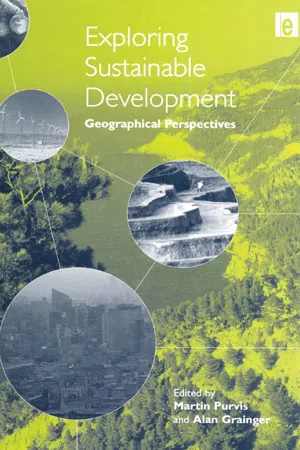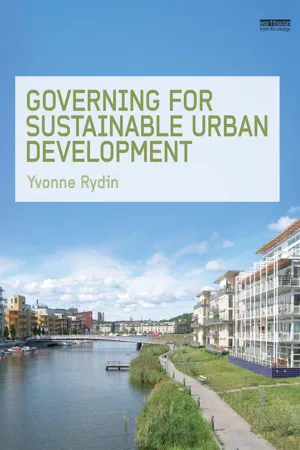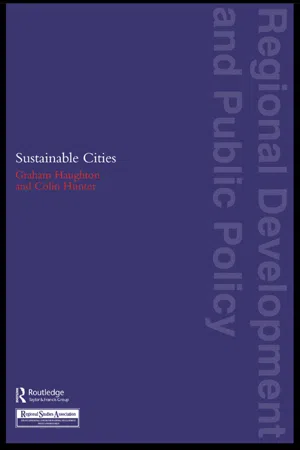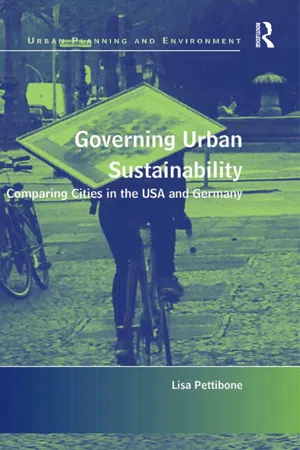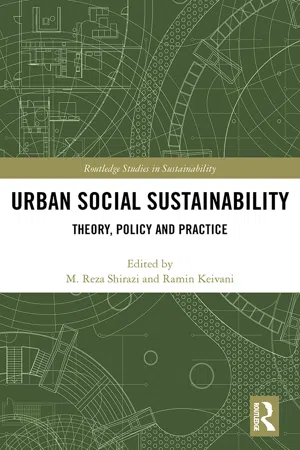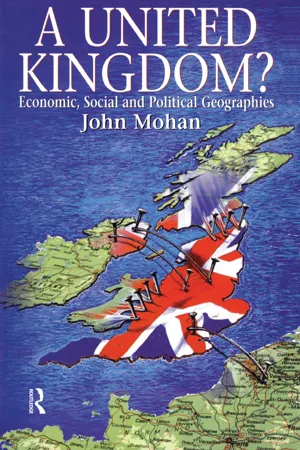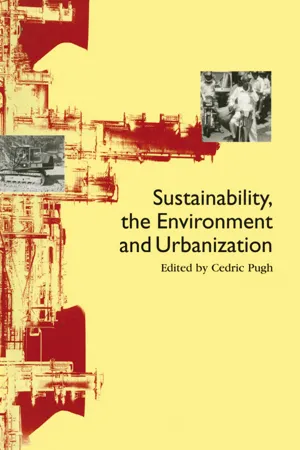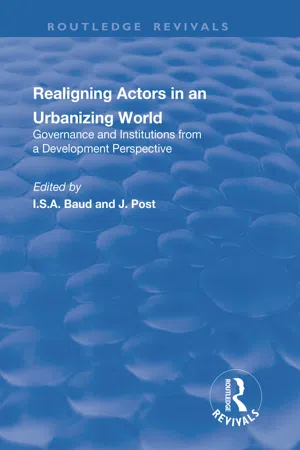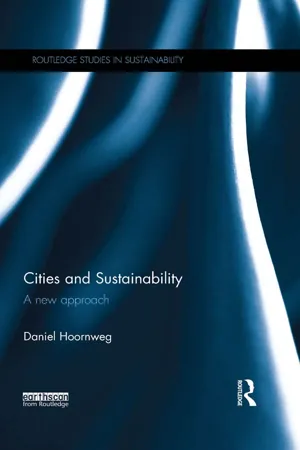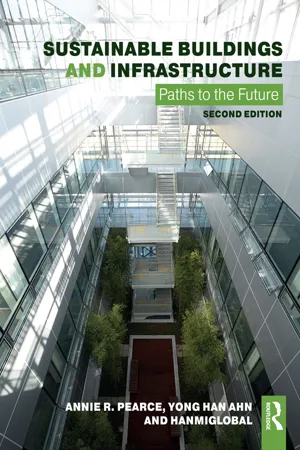Geography
Urban Sustainability
Urban sustainability refers to the ability of a city or urban area to meet the needs of its current population without compromising the ability of future generations to meet their own needs. This involves creating environmentally friendly and efficient infrastructure, promoting social equity, and fostering economic prosperity. It aims to balance economic, social, and environmental factors to ensure the long-term viability of urban areas.
Written by Perlego with AI-assistance
Related key terms
12 Key excerpts on "Urban Sustainability"
- eBook - ePub
Exploring Sustainable Development
Geographical Perspectives
- Martin Purvis, Alan Grainger(Authors)
- 2013(Publication Date)
- Routledge(Publisher)
The growing geographical literature on sustainable development performs an important educational role: first, in raising awareness of the current unsustainability of economic and social systems worldwide and, second, in fostering debate about the need for change. If there is to be significant progress towards greater sustainability those currently in education – who will become tomorrow’s consumers, workers, employers, voters and politicians – must make more informed decisions about the balance to be struck between aspirations for economic growth, social progress and environmental conservation. However, the potential also exists for geography to play a more explicit role in refining current understanding of the concept of sustainable development and its practical application. Indications that proposals for securing greater sustainability in practice often intersect with geography’s defining interests in place, space and the spatial patterning and scale of activity provide some obvious points of departure.Spatial form and scale
There are good reasons for thinking that the sustainability of development is, in part, related to its spatial form. It has long been evident, for example, that the concentration of population and economic activity in urban centres can create particular social and environmental stresses. Equally, it is hardly novel to argue that attention to the location and spatial design of development can reduce associated costs – both internal and external – and assist the delivery of intended benefits. It is unsurprising, therefore, that spatial form has been identified as a key to creating greater sustainability in a variety of contexts, including the urban. This is evident in calls for the development of compact cities, with a greater local diversity of population and land use than is currently the case (see Chapter 6 - eBook - ePub
- Yvonne Rydin(Author)
- 2012(Publication Date)
- Routledge(Publisher)
Figure 1.2 for both of these.) And third, it is about using the urban level of governance to pursue action for sustainability and to demonstrate commitment to the sustainable development agenda.Figure 1.2 Closing the Urban Resource LoopIt is perhaps not surprising, since so many people live in urban areas, that these areas make a major contribution to the unsustainability of contemporary life. That urban areas play a significant part in the economic life of countries is clear. Urbanization as a process is closely linked to economic growth. For most countries the point of take-off into industrialization comes when agricultural productivity allows significant movement of the rural population into towns and cities. This is because there are considerable economic benefits to be derived from the proximity of people and businesses within an urban context; economists term these economies of agglomeration.So the unsustainable nature of urban areas derives from the social and environmental impact of growing urban economic activity. While rural areas have always also exhibited considerable poverty, the concentration of poverty in urban areas and its juxtaposition alongside urban affluence has highlighted the extent to which the gains from urban economic activity are unequally distributed within towns and cities. This is given physical expression within every urban area in the form of substandard housing, ranging from slums and shanty towns to homes that appear adequate on the outside but lack basic amenities inside and are overcrowded and in a poor state of repair.In lower-income countries, the problem is acute. Data from the UN Global Urban Observatory suggest that slum and squatter settlement dwellers represent as much as 70 per cent of the urban population in Addis Ababa, Cairo, Casablanca and Luanda – all in Africa. They identify 24 cities across Africa, Asia and South America where the proportion is at least 30 per cent. Lack of access to safe water and adequate sanitation is the biggest public health risk globally. This problem is not more common in urban areas than rural areas but it is readily apparent in the growing cities of the global South. The UN claims that: - eBook - ePub
- Graham Haughton, Colin Hunter(Authors)
- 2004(Publication Date)
- Routledge(Publisher)
In practice, the objective of moving towards becoming a more sustainable city needs to be set in the context of a broader sustainable society, and related to its contribution to global sustainable development (Leff 1990, OECD 1990). As an essentially human-made artifact, however, the sustainable city needs to aim towards more than just ecological balance at all these geographical scales, it also needs to sustain its own unique contribution to the environment, in terms of its built form in particular. A city which allows its handsome cathedrals and city halls to be taken down and replaced with aesthetically unpleasing buildings or uses, damages its own environment in much the same way as one which surrenders itself to the private motor car. A sustainable city is not so much an entity, an end point, as a process of contributing to global sustainable development. It implies a state of dynamic equilibrium within the global environment, not simply a state of local equilibrium. As a working definition for the purposes of this book:a sustainable city is one in which its people and businesses continuouslyendeavour to improve their natural, built and cultural environments atneighbourhood and regional levels, whilst working in ways which alwayssupport the goal of global sustainable development.1.3SUMMARY: Urban Sustainability AND GLOBAL INTERDEPENDENCIES
As economies and environmental problems have become increasingly international in scope, it has become ever more difficult to view cities meaningfully in isolation from each other or their less urbanised hinterlands. This is far from a new insight: the characterisation of cities as open systems, integrated into broader systems of environment and economy has long been accepted by geographers and others (Perloff 1969). Most importantly, it is important to recognise the ways in which economic development and environmental change are connected, on urban and global scales. Cities are connected to each other—and to resource areas in particular—by an increasingly complex web of links, in production systems, in finance, in resource usage and in the environmental problems which they both create and face.In terms of the root causes of many of the problems which cities face, it is important to understand the economic and social relationships on local and global scales which have caused them to become ‘unsustainable’. This leads to an important question: since many of the problems of cities are related to the broader social and economic relations within which they must operate, to what extent can we look to cities to provide their own solutions to the problems they face? - eBook - ePub
Governing Urban Sustainability
Comparing Cities in the USA and Germany
- Lisa Pettibone(Author)
- 2016(Publication Date)
- Routledge(Publisher)
PART I Defining Urban Sustainability DOI: 10.4324/9781315585635-1Passage contains an image
Chapter 1 A New Framework for Urban Sustainability Governance
DOI: 10.4324/9781315585635-2Decision-makers today are faced with a number of interconnected challenges: a complex ecological crisis that includes biodiversity loss, multiple forms of pollution, and climate change; an increasingly precarious global financial system that has led to two recent crises, increased inequality, and growing social unrest; and growing tension between the Global South and the Global North about how to address these issues. But these challenges have been increasingly linked to solutions called for by sustainability, a worldview that has emerged from outside traditional policymaking channels and reframes these problems in a new way (Lafferty, 2004 ). Sustainability uses a reflexive, deliberative, systems-based approach to advance solutions that work within the long-term and acknowledge ecological limits. To achieve this, sustainability calls for a massive societal transformation (for example, McCormick et al., 2013 ; WBGU, 2011).Such a transformation entails dramatic restructuring of social, political, and technical systems and institutions in order to reduce wasteful resource use, promote equity and inclusion, all while maintaining a good quality of life and without collapsing economic or ecological systems (WBGU, 2011 ). This tall order is the focus of research on sustainability governance, which focuses on transforming socio-political structures and processes within the framework of a broader transition to sustainability (Lafferty, 2004 ; Meadowcroft, Farrell, and Spangenberg, 2005 ). Sustainability governance requires new forms of decision-making to reframe problems and work in new ways to resolve them (Adger and Jordan, 2009 ; Voß, Bauknecht, and Kemp, 2006 - eBook - ePub
Urban Social Sustainability
Theory, Policy and Practice
- M. Shirazi, Ramin Keivani(Authors)
- 2019(Publication Date)
- Routledge(Publisher)
Everything urban, in the context we are discussing, points to a range of areas such as urban policies, strategic plans, future plans, (re)development projects, local initiatives, housing developments, etc. This does not mean an over-emphasis on social sustainability dimension, or isolating it from other dimensions, but calls for a dialogue with other aspects of sustainable development. Urban social sustainability as an urban agenda has three fundamental elements: recognition, integration, and monitoring. It starts with recognition: recognising that there is a social sustainability dimension for every (re)development project or programming that has to be respected and planned for. Regardless of the scale of operation, this recognition paves the way for planning and programming. It does not take place in a vacuum, but in a social arena where multiple agents are engaged, and pushed by societal demands and public awareness. The other two elements of integration and monitoring are part of the governance of urban social sustainability. Governance of urban social sustainability is circular (Figure 11.1); it starts with a dialogical planning and design, goes further with implementation, and continues with participatory monitoring (with a focus on community oversight). The circle closes with periodic re-visit, which urges reforms or if needed re-structuring in planning, design, or even monitoring mechanism. The re-revisit includes evaluation of decision-making, planning, design, and implementation procedures to evaluate the achievements. In larger scales, for example urban policies that are long term and unlimited, the circle repeats itself several times - eBook - ePub
A United Kingdom?
Economic, Social and Political Geographies
- John Mohan(Author)
- 2014(Publication Date)
- Routledge(Publisher)
13 SUSTAINABLE GEOGRAPHIES?13.1 INTRODUCTIONMany texts on the UK’s human geography have, in the past, emphasised the connections between physical (especially mineral) resources, patterns of economic activity, and population distribution. It might be argued that a predominantly service-based economy has been (at least partially) liberated from the constraints of its physical resource base. But existing patterns of development (and especially of consumption) threaten to reopen the issue of physical constraints, while changes in agricultural practices and the inexorable rise in energy consumption raise entirely new issues of risk. Hence a discussion of sustainability is central to the concerns of this book.The Bruntland Commission on Environment and Development is widely credited with placing sustainability at the centre of political debate. This Commission argued that, in order to allow all humanity to attain Western consumption levels, the resources of ten Earths would be required. Moreover, when even current levels of energy consumption are credited with responsibility for global warming, and when renewable resources such as forests and fisheries are believed to be on the verge of irreversible decline, it must be acknowledged that ‘humankind is getting within touching distance of the determining factors for global carrying capacity’ (McLaren et al., 1998, 12). In the past the result might have been localised famine and economic collapse; ‘today the whole planet is local’ (ibid.).The problem, of course, is that environmental problems are the result of decisions by millions of individuals to consume resources. Driven by imperatives to increase economic growth, the promotion of personal consumption has become ‘probably the single most important objective of modern politics’ (Jacobs, 1997, 47). The obsession of politicians with ‘consumer confidence’ and the elusive ‘feelgood factor’ makes this clear. Governments are not going to advocate a reduction in living standards. Inability to check consumption ultimately is therefore implicated in causing the greenhouse effect through the high levels of energy consumption associated with Western lifestyles and the depletion of mineral and timber resources, while demands for cheap food lead to agricultural intensification and, in turn, pollution and pesticide hazards, to say nothing of exposure to new risks such as BSE. - eBook - ePub
- Cedric Pugh(Author)
- 2014(Publication Date)
- Routledge(Publisher)
In the 1990s UNEP and the UNCHS have moved into closer organizational linkage and collaboration. This both reflects and promotes the relevance of conditions in human settlements as having environmental impact and importance. Among the relevant conditions are the particularly important ones of insanitary conditions in large proportions of low-income settlements in cities in developing countries, air pollution from some manufacturing processes and motor vehicle emissions into the atmosphere. Consequently, the cause for environmentalism has simultaneously included the ‘green’ agenda (for nature) and the ‘brown’ agenda (for the elimination of adverse urban health impacts). The ‘brown’ has some causal consequences for the ‘green’. As the ‘brown’ agenda led to greater attention in intellectual thinking and policy making on environmental agendas, so the meaning of sustainability widened and deepened. In the context of human settlements the idea of sustainability had to cover a range of economic, political and financial issues. It was not simply a matter of correcting physical environmental adversity. Sustainability had relevance to such matters as the costs and benefits of correction, the managerial and financial capability of localized government agencies to maintain viable systems of public finance to resource environmental improvement, and the economic development of cities. Also, since the localized and wider governance of cities was usually multi-institutional, issues of jurisdictional coherence and localized cooperation became important. The application of the idea of sustainability portended more than it seemed, and certainly a growing complexity in the evolution of environmentalism.The idea of sustainability had fundamental importance in the 1987 Brundtland Report (WCED, 1987). ‘Sustainability’ accelerated the change in thinking in environmentalism. For example, relevance was extended to ‘renewable’ and ‘substitutable’ resources, as well as to the earlier attentiveness to ‘exhaustible’ resources. This kind of change in thinking widened the environmental sphere in intellectual and practised economics: concerns and applications had to be related to economic development as a whole, not just to efficiencies in energy-related resources. Changes in thinking also contributed to the growing realization that a new international impetus was required in environmentalism. The Norwegian prime minister, Brundtland, who had headed the World Commission on Environment and Development (WCED), along with other political leaders, herself became an active advocate for significant international focus. Consequently, UNEP undertook preparations for a UN conference, supported and mandated by UN resolution 44/228 in 1989. Thus, the idea of sustainability had a significant international forum, set for the 1992 UNCED meeting in Rio de Janeiro. The conference would have a ‘prepared’ and an ‘added’ agenda. The prepared agenda would consist of the range of elements that were significant in the expression of environmentalism in the late 1980s. These elements would include such considerations as: - eBook - ePub
Re-aligning Actors in an Urbanized World
Governance and Institutions from a Development Perspective
- I. Baud, J. Post(Authors)
- 2018(Publication Date)
- Routledge(Publisher)
Also required in this process of management are greater ‘environmental efficiency’ and ‘social efficiency’. ‘Environmental efficiency means achieving maximum economic benefit for each unit of natural resources used and waste produced’ (ESC Report, 1994). The reduction in natural resources extraction and use mentioned above is a major part of such strategies. ‘Social efficiency means obtaining the greatest human benefit from each unit of economic activity’ (ESC Report, 1994, p. 43). The final, political point is that strategies aimed at achieving sustainability should promote equity in various forms. Types of equity identified include that between different geographical areas of the world (geographical equity) - such as between industrialized and developing countries - between groups with different income levels (intra-generational equity), and between current and future generations (inter-generational) (Haughton, 1999). Limitations When trying to apply the concept of ecological sustainability to city-hinter-land relations, one faces several limitations. First of all, a comprehensive analytical model combining the different levels of analysis needed for the urban context has not yet been developed. Researchers have focused either on natural ecosystems - analyzing the impacts of human activity, and providing us with a wealth of information on changes in biodiversity in different ecosystems - or on the management of natural resources and the resource requirements for maintaining certain standards of resource delivery for the urban population (applying health standards and ignoring the limits set by the regenerative capacity of ecosystems). One well-known approach is the ‘ecological footprint’ concept (Rees, 1992). This footprint measures the total land area required to maintain the food, water, energy, and waste-disposal demands per person, per product, or per city - eBook - ePub
Resilient Sustainable Cities
A Future
- Leonie Pearson, Peter Newton, Peter Roberts(Authors)
- 2014(Publication Date)
- Routledge(Publisher)
We can position these two terms here as complementary but separate axes of performance that cities aspiring for longevity need to achieve: that is, where sustainable development is measured on the vertical axis (from sustainable to unsustainable) and resilience (from brittle to resilient) is on the horizontal axis to provide for a potential mapping of the states of current cities. Such dual-factor mappings are now emerging for particular dimensions of city or country performance; for example, sustainability and liveability (Newton 2012); happiness and GDP (Worldwatch Institute 2008, cited in Jackson 2009); health and income inequality (Wilkinson and Pickett 2009); and sustainability and equity (UNDP 2011), among others. However, resilience measures for cities are less advanced (UNISDR 2012) and do not yet feature on such radar screens.This realization that the world needs sustainable and resilient cities is a clear message coming from governments, communities, researchers, society and the stressed environment, and it is beginning to reverberate through the media. It is the aim of this book to clarify the Urban Sustainability—resilience agenda as well as help in its implementation in the future planning and management of our cities by asking leading practitioners and thought leaders to provide their insights on:- What is a resilient, sustainable city?
- And how can it be achieved?
Following the path-breaking work of the World Commission on Environment and Development (1987) and the host of government policy statements and practical actions which followed, many books and papers have been written on particular aspects of sustainable urban development (e.g. transport, housing, infrastructure, service delivery, energy and planning requirements), and risk recovery planning of cities to ensure they are more ‘resilient’ to crises (e.g. hurricanes, tsunamis, etc.) in the manner in which they rebound, bounce back. This sector-specific approach to planning and risk management of current city life constrains urban futures to sub-optimal performance outcomes and does not necessarily position cities to be better able to cope with holistic ‘slow-burn’ or ‘sudden-shock’ issues. This is the distinguishing feature of this collection compared to current offerings: an attempt to provide a more integrated approach for long-term future planning within the context of the city represented as a whole socio-technical—built—environmental system - eBook - ePub
Cities and Sustainability
A new approach
- Daniel Hoornweg(Author)
- 2016(Publication Date)
- Routledge(Publisher)
3 The urbanscape Why cities are at the core of sustainabilityMuch on sustainable development is written from the perspective of countries, or from one of the multitude of people to have attended some related UN conference. Cities as the single largest drivers of the world’s economy, and the single largest generators of pollution and waste, are relatively quiet in the sustainable development debate. This is mostly by design, as cities usually defer to national (or state/provincial) representatives. Local imperatives are often difficult to contextualize in global conversations.Corporations and countries are usually the main agencies to advocate for and measure sustainability. In the case of planetary boundaries, a global metric is used. Corporations usually pursue sustainable development objectives within the context of market-share protection and enhancement. And as future companies are not able to lobby and promote their perspective, existing corporations implicitly encourage the status quo and sustained profitability. Countries advocating for sustainable development must do so within the constraints of possible regional tensions at home, protection of territorial integrity, and geopolitical considerations. Cities, on the other hand, are increasingly measuring sustainability through service provision standards and local quality of life (well-being).Measuring sustainability
Countries are transient, cities less so. Heads of state spend considerable efforts safeguarding country borders and powers, mayors less so. For example, two-thirds of today’s 195 member countries did not exist in 1945, when the UN was established. Every one of the 120 ‘Future Five’ cities was a large urban conurbation in 1945, most having had continuous human habitation at their location for more than 200 years. The political borders of cities may be as fluid as national borders; however, sustained residency in key urban areas is common for most cities. - eBook - ePub
- David Satterthwaite(Author)
- 2021(Publication Date)
- Routledge(Publisher)
Agenda 21 and its prescriptions for solving global environmental problems at the local level are well known. Building on Agenda 21, the Habitat Agenda, signed by 180 nations at the recent Habitat II conference in Istanbul, will also strongly influence the way we run cities. It states: ‘Human settlements shall be planned, developed and improved in a manner that takes full account of sustainable development principles and all their components, as set out in Agenda 21 … We need to respect the carrying capacity of ecosystems and preservation of opportunities for future generations. Production, consumption and transport should be managed in ways that protect and conserve the stock of resources while drawing upon them. Science and technology have a crucial role in shaping sustainable human settlements and sustaining the ecosystems they depend upon.’ 10 What, then, is a sustainable city? Here is a provisional definition: A ‘sustainable city’ is a city that works so that all its citizens are able to meet their own needs without endangering the well-being of the natural world or the living conditions of other people, now or in the future. This definition concentrates the mind on fundamentals. In the first instance the emphasis is on people and their needs for long-term survival. Human needs include good quality air and water, healthy food and good housing; they also encompass quality education, a vibrant culture, good health care, satisfying employment or occupation, and the sharing of wealth; as well as factors such as safety in public places, supportive relationships, equal opportunities and freedom of expression; and meeting the special needs of the young, the old or the disabled - eBook - ePub
Sustainable Buildings and Infrastructure
Paths to the Future
- Annie R. Pearce, Yong Han Ahn, Ltd HanmiGlobal Co(Authors)
- 2017(Publication Date)
- Routledge(Publisher)
The movement of population to urban centres will create a need for new types of development that can accommodate higher human density without compromising quality of life. These new developments must provide for human needs such as food, water and energy which in the past were imported from non-urban areas, leading to net zero energy and net zero water buildings. Vertical farming, which involves using urban infrastructure and buildings as a base for agriculture and food growing, will increase as the cost of transportation increases and city dwellers seek to become less dependent on external supplies of resources. New solutions to address the challenges of urban farming, such as limitations of solar geometry and energy requirements for pumping and lighting, will need to be developed. Ubiquitous communication systems via the internet will also affect transportation patterns of people within urban areas as an increasing number of people telecommute and socialize online instead of physically travelling from place to place.While the built environment of tomorrow is certain to look and behave differently from today’s facilities and infrastructure, no one knows exactly what form it will take or what functions it will provide. What is certain is that it must be dramatically more resource efficient than the built environment of today to accommodate the ever-increasing needs of a changing and growing population. Sustainable practices for the planning, design, construction, operations and end-of-lifecycle of facility and infrastructure systems offer an approach to achieve this end.Overview of the book
With all of the potential benefits associated with sustainable design and construction and the challenges to be faced in the coming years, many organizations are seeking ways to improve the sustainability of their buildings. The purpose of this book is to provide an introduction on how to improve the sustainability of the built environment.Chapter 2
Index pages curate the most relevant extracts from our library of academic textbooks. They’ve been created using an in-house natural language model (NLM), each adding context and meaning to key research topics.
